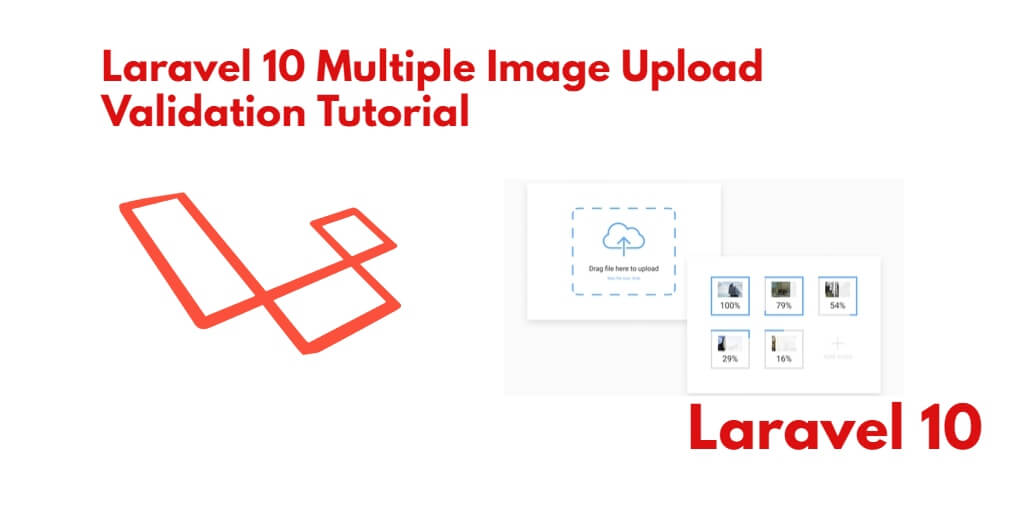Uploading and validating multiple image uploads is very easy with Laravel 10 web application. For this, only some pre-defined rules and methods of Laravel have to be used. So whenever the file is sent for upload to the controller method. Then you can validate the images according to the type, size and dimensional according to the validation rules.
In this tutorial, you will learn how to implement a multiple image upload functionality with validation in Laravel 10 web applications. By following this guide, you will be able to validate the types, dimensions, and sizes of the uploaded images, ensuring that only valid images are accepted.
Laravel 10 Multiple Image Upload With Validation Tutorial
Steps to upload multiple images in laravel 10 apps with validation:
- Step 1 – Install Laravel 10 Application
- Step 2 – Configure Database In .env File
- Step 3 – Create Photo Model & Migration
- Step 4 – Create Routes
- Step 5 – Create Controller using Artisan Command
- Step 6 – Create Blade View
- Step 7 – Start Development Server
- Step 8 – Start App on Browser
Step 1 – Install Laravel 10 Application
First of all, start your terminal to download or install Laravel 10 new setup. Run the following commands on terminal to install the new Laravel 10 app on your system:
//for windows user cd xampp/htdocs //for ubuntu user cd var/www/html
Then install Laravel 10 latest application using the following command:
composer create-project --prefer-dist laravel/laravel blog
Step 2 – Configure Database In .env File
In this step, Configure your database with your apps. So, visit your app root directory and find .env file. Then configure database details as follows:
DB_CONNECTION=mysql DB_HOST=127.0.0.1 DB_PORT=3306 DB_DATABASE=db name DB_USERNAME=db user name DB_PASSWORD=db password
Step 3 – Create Photo Model & Migration
In this step, use the below given command to create phtoto migration and model file.
First of all, navigate to project by using the following command:
cd / blog
Then create model and migration file by using the following command:
php artisan make:model Photo -m
The above command will create two files into your Laravel 10 multiple image upload with validation tutorial app, which is located inside the following locations:
- blog/app/Models/Photo.php
- blog/database/migrations/create_photos_table.php
So, find create_photos_table.php file inside blog/database/migrations/ directory. Then open this file and add the following code into function up() on this file:
public function up()
{
Schema::create('photos', function (Blueprint $table) {
$table->id();
$table->string('title');
$table->string('path');
$table->timestamps();
});
}
Now, open again your terminal and type the following command on cmd to create tables into your selected database:
php artisan migrate
Step 4 – Create Routes
In this step, open your web.php file, so navigate inside routes directory. Then update the following routes into the web.php file:
use App\Http\Controllers\UploadImagesController;
Route::get('multiple-image-upload', [UploadImagesController::class, 'index']);
Route::post('multiple-image-upload', [UploadImagesController::class, 'store']);
Step 5 – Create Controller using Artisan Command
In this step, use the below-given php artisan command to create a controller:
php artisan make:controller UploadImagesController
The above command will create the UploadImagesController.php file, which is located inside the blog/app/Http/Controllers/ directory.
So open the UploadImagesController.php file and add the following code to it:
<?php
namespace App\Http\Controllers;
use Illuminate\Http\Request;
use App\Models\Photo;
class UploadImagesController extends Controller
{
public function index()
{
return view('multiple-image-upload');
}
public function store(Request $request)
{
$validateImageData = $request->validate([
'images' => 'required',
'images.*' => 'mimes:jpg,png,jpeg,gif,svg'
]);
if($request->hasfile('images'))
{
foreach($request->file('images') as $key => $file)
{
$path = $file->store('public/images');
$name = $file->getClientOriginalName();
$insert[$key]['title'] = $name;
$insert[$key]['path'] = $path;
}
}
Photo::insert($insert);
return redirect('multiple-image-upload')->with('status', 'Multiple Images has been uploaded successfully');
}
}
Step 6 – Create Blade Views
In step this, Navigate to resources/views directory. And then create new blade view file that named multiple-image-upload.blade.php inside this directory.
So, open this multiple-image-upload.blade.php file in text editor and update the following code into it:
<!DOCTYPE html>
<html>
<head>
<title>Uploading Multiple Images In Laravel 10 With Validation</title>
<meta name="csrf-token" content="{{ csrf_token() }}">
<link rel="stylesheet" href="https://stackpath.bootstrapcdn.com/bootstrap/4.5.2/css/bootstrap.min.css">
</head>
<body>
<div class="container mt-5">
@if(session('status'))
<div class="alert alert-success">
{{ session('status') }}
</div>
@endif
<div class="main">
<div class="card-header text-center font-weight-bold mb-2">
<h2>Laravel 10 Upload Multiple Image Validation</h2>
</div>
<form name="upload-multiple-image" method="POST" action="{{ url('upload-multiple-image') }}" accept-charset="utf-8" enctype="multipart/form-data">
@csrf
<div class="row">
<div class="col-md-12">
<div class="form-group">
<div class="input-group">
<div class="input-group-prepend">
<span class="input-group-text" id="inputGroupFileAddon01">Upload</span>
</div>
<div class="custom-file">
<input type="file" class="custom-file-input" id="images" name="images[]" multiple="">
<label class="custom-file-label" for="inputGroupFile01">Choose Multiple Images</label>
</div>
</div>
</div>
@error('images')
<div class="alert alert-danger mt-1 mb-1">{{ $message }}</div>
@enderror
</div>
<div class="col-md-12">
<button type="submit" class="btn btn-primary" id="submit">Submit</button>
</div>
</div>
</form>
</div>
</div>
</body>
</html>
Step 7 – Start Development Server
In this step, run the following command on cmd to start development server:
php artisan serve
Step 8 – Start App on Browser
In step this, run this app on browser, so open your browser and fire the following url into browser:
http://127.0.0.1:8000/upload-multiple-image
